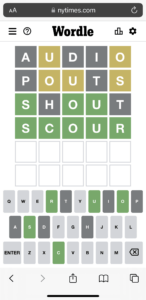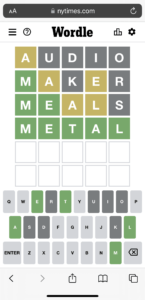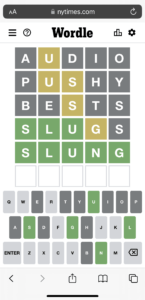Introduction
Wordle is a game created by Josh Wardle and published by New York Times. It is a browser-based game where players have six tries to guess a five-letter word of the day.
Target Audience
The target audience of Wordle is adults who are interested in word games such as crosswords. As it is published by the New York Times, the target audience has a large overlap with the readers of the New York Times. Wordle is also very accessible to a wider audience and is quick to play and learn.

Formal Elements
Players: Wordle is a single-player v. game type of game. You play individually to try to solve a word puzzle presented by the game.
Procedures: The player is first presented with a blank grid. They can type in letters on a keyboard to guess words. The letters in the word that the player guessed become color coded – green means the letter is in the correct position, yellow means the letter is in the target word but not in the correct position, and gray means the letter is not in the target word. The player can continue guessing words in this fashion until they guess correctly or use up their six guesses.
Rules: The player must guess one word per turn. Each guess must be a valid word in the Wordle dictionary. They have six tries to guess the correct target word based on the color-coded hints they are given after each guess.
Outcomes: The player either loses by not successfully guessing the word in six tries or wins by guessing the word in six tries or less. Preferably, the uses the smallest number of guesses possible.
Objectives: The objective is to guess the target word in the fewest number of guesses as possible.
Boundaries: Players are limited by the fact that they can take at most six guesses and the fact that each guess must be a five-letter word that is valid in the Wordle dictionary.
Conflict: A source of conflict is needing to find the most effective words to guess to successfully solve the puzzle. There may be conflicts with constraints with the words the player knows or thinks of. There are also conflicts for where to place specific letters in each word and by the fact that the player can only use valid words.
Resources: The guesses and the color coded hints act as resources which the player can use to further refine their guesses and get closer to reaching the correct answer.

Types of Fun
The main type of fun in Wordle is challenge. Players are challenged by the constraints imposed by the game to reach the goal of guessing the target word. The appeal comes from the difficulty of working within these constraints to reach the correct answer. There is also a fellowship type of fun because the game updates each day with a new word that is the same for everyone playing the game. So, there is a social connection with all players on the same day facing the same challenge.
Success and Failures
Successes: The game is compelling with its relatively simple and minimalist mechanics. The graphic design with the color-coded tiles is very clean and gives the game a very elegant feel. The choice for the game to have the same word for everyone playing for a single day keeps players connected and wanted to establish a habit of playing.
Failures: It may not be initially very clear what the different colors of the tiles mean. However, after playing, it becomes intuitive. At times, the selected word is obscure, so the player may feel discouraged by the difficulty.

Changes
There could possibly be a tutorial for players instead of instruction text to teach players how to play the game. There could also be the option of different game modes that involve changing the length of the word or the number of guesses to help scale for difficulty.
Wordle can be classified as a logic puzzle since there is an amount of logic and deduction involved in inferring where letters should be placed and in formulating effective guesses. One reason Wordle is an effective puzzle is because it triggers the “V-8” response. After the correct word is revealed, I often found myself thinking, “Yes, of course that was the answer!” It is also fun because of the novelty of using words to guess other words and is often tricky but not too hard.


